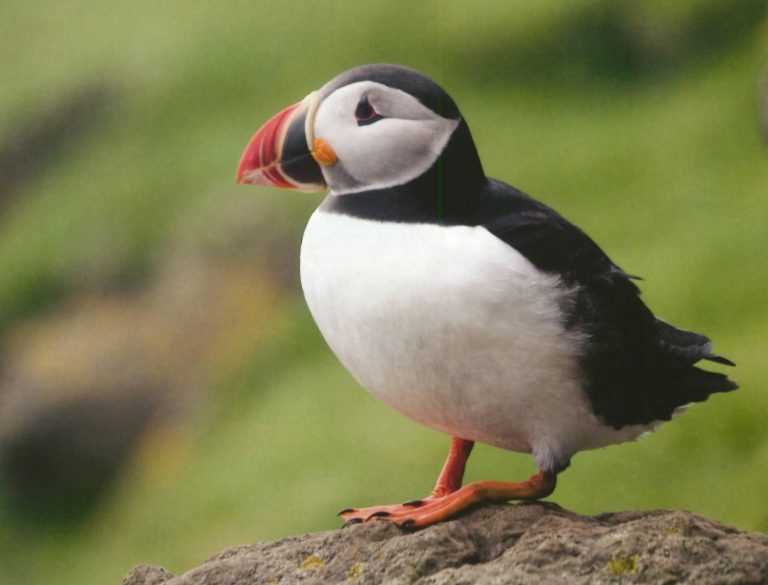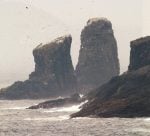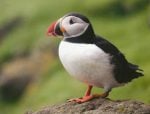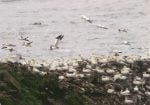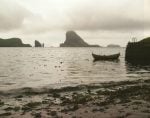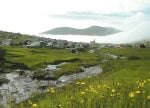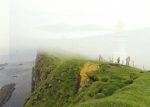Inhabitants: 2935 Area: 188 km2
Vágoy is the westernmost of the major islands in Faroe. Vágar has everything that the hospitable Faroese can offer their guests. The bird paradise and a nature pearl Mykines is also part of the area.
Every visitor traveling to Faroe by air lands in Vágoy. This is the island where a traveler can get any experience he wants, such as hikes, pony treks, boat trips, cultural events or accommodation.
Vágoy has three municipalities, Sørvágur, Miðvágur and Sanda- vágur.
Sørvágur comprises Sørvágur, Bøur, Gásadalur and Mykines.
Miðvágur also includes Vatnsoyrar, while Sandavágur is a municipality of its own. It used to include the settlement of Slættanes on the north eastern corner of the island, but now its five empty houses are only used as summer cottages.
The economy of Vágoy rests on various industries, the fisheries being the mainstay as usual in Faroe. But you also find enterprises such as J. K. Joensen’s mechanical workshop, Vatnsoyra Snikkaravirki producing house building components, Føroya Gluggi at Miðvágur making windows etc.
The biggest employer on Vágoy is without compare Vága Flog- havn, the national airport. It is the HQ of the airport authority, SLV, and of the two airlines, Atlantic Airways and Faroejet, besides a couple of private operators specializing in passerger services, hotel, catering etc.
Vágoy has a variety of commercial businesses spread over the major towns and Vatnsoyrar. There is also some agriculture.
In terms of sports Vágoy has teams in most branches competing at national level.
Visitors to Vágoy has a good choice of accommodation, both at hotels, hostels, B & Bs etc. A caravan and tent camp site is being planned.
Nature lovers do well on Vágoy and Mykines. In plain speech bird watchers do themselves a disservice if they miss Mykines.
Mykines is known as the bird island above others with its thousands of sea birds of all species, in particular the puffin.
But the isle is the only place in Faroe where the gannet breeds. Along its coasts there are seals galore visible from above and from the boat as it cruises along the shore.
The rolling landscape of Vágoy makes it well suited for country walking between the villages and is highly favoured by horse enthusiasts. The two biggest lakes in Faroe are on Vágoy besides smaller lakes with trout in them.
A short, easy and pretty nature walk is the trip up to Bessa- skoraregg. From there the view is magnificent over the watery expanse to the south and to the Sørvágur cliffs to the east. The walk starts from Hotel Vágar along Stórá. The path up to Egg is well trodden. From there the view over the Dunnes rock formations with puffin and fullmar nesting there is quite a sight. One marvels at the sheep grazing on the near vertical grassy slopes of the cliffs. The walkers pass the Fransahola (lit. “French Cave”), where people of Sørvágur sought refuge and hid valuables from marauding pirates. (Pirates then were thought to come from France, Turkey or Ireland).
Trælanípan conjures up a most unpleasant historic memory, and the walk to this now peaceful place
starts at Miðvágur along Ovara- gøta and ends at the 148 metre high overhanging point of Trælanípan, whose name implies the place where old and useless slaves were pushed over the edge. From Trælanípan there is a grand view of the islands to the west and south. When the wind is southwesterly the breaking surf underneath is quite spectacular.
On the way across the heath one passes places where the people of Miðvágur formerly tended their cattle, cut and worked the peat and fished trout for supper. There is a teeming birdlife both audible and visible all around the attentive walker.
At the southern end of the Lake, Oyrar, the impressive waterfall, Bøsdalafossur, throws itself over the edge and into the ocean below. From there one may enjoy the impressive view to Geituskorar- drangur and the cliffs to the west.
One may also board the licensed lake boat and enjoy the view on all sides as if sailing in a glass conservatory. The boat leaves from the old seaplane slipway built by the British occupying forces during WW II and called “Lakeside”. The boat sails along the western shore to the southern end of the Lake, at Oyrar.
One of the most magnificent walks must be the one along the old village path to Gásadalur.
Gásadalur was the last village in Faroe to be connected by tunnel with the rest of the country. The path is winding and steep. Initially it is an exhausting walk, but it gets easier after the first slope.
The walking party makes a stop at Líksteinur, where the carriers put down the hearse and rested when carrying dead people from Gásadalur, where there was no cemetry, to Bøur. Further up there is the spring called Vívd, where the water was regarded as holy. Legend has it that drinking from it keeps you young. Up at the Giant’s Footprint there is a fantastic view over Tindhólmur, Drang- arnar and Mykines. At Skarðið (the Pass) one sees down over beautiful Gásadalur hundreds of metres below.
Several passenger boats sail out of the harbour at Sørvágur and offer various options. One may sail to the south side of the island and then east along the towering Sørvágur cliffs, into grottos, inside the free standing rock formations and under overhanging precipices. Birds in the cliffs, sheep on the grassy slopes and seals on the skerries are sights to please the eye. If one chooses to turn to the island’s north shore, the promontory of Barðið and the alternating sky- high and flat landscape around the former settlement of Víkar has a pristine appeal to the beholder.
Tindhólmur must be the most depicted place in the country with its rare shape sheltering Sørvág’s fiord. The boat trip runs past it. The return journey takes you past Gásadalur to view the village from the sea.
Sailing out to Mykines and around the island is for certain an experience for life. The departure point is the marina at Sørvágur and the trip runs past Tindhólmur straight to Mykines. The boat enters the ravine of Borgargjógv, where the sea may be dead calm even if the currents rush just outside. The skipper has expert knowledge and sails past points and gorges all the way west to the boat landing. After a brief stop for snapshots and filming the journey continues west towards Hólmurin, the islet. Here are the nesting ledges of the gannet, while the air is teeming with puffins, gulls, fulmars and other seabirds nesting above, and the seals drowsily raise their sleek heads over the surface.
Mykines
Mykines is the westernmost of the Faroe islands and world famous for its rich birdlife. The island has regular ferry and helicopter connections with Vágar airport and the mainland.
The boat trip traveler has about an hour to inspect for herself the village. It is cosy and welcoming with its old, tarred and turfed houses and the stone church from 1879. This is where the best known Faroe painter S.J. Mikines was born and grew up, and here he was inspired for his major works of art. Fie painted a lot here.
The walk out to the Fiólmur (Islet) is highly recommended. The parh goes up to Rógvan and then down again on the outside down to the suspension bridge (the only one across the Atlantic, they say) 35 metres over sea level. The chasm is an experience in itself, and the guide will tell his guests everything about the puffin holes and the gannet stock. The return walk takes you along the edge, and from there people can see seals in the sea below.


